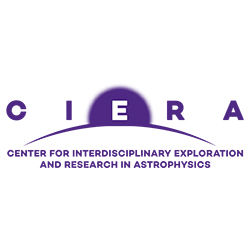CIERA Theory Group: Lucy McNeil, Erin Cox

When:
Friday, November 30, 2018
12:00 PM - 1:30 PM CT
Where: Technological Institute, F160, 2145 Sheridan Road, Evanston, IL 60208 map it
Audience: Faculty/Staff - Student - Post Docs/Docs - Graduate Students
Cost: Free
Contact:
CIERA Astrophysics
(847) 491-8646
Group: CIERA - Theory Group Meetings
Category: Lectures & Meetings
Description:
Friday Theory Meetings for Northwestern University's Center for Interdisciplinary Exploration and Research in Astrophysics (CIERA), this week featuring:
Lucy McNeil (Monash)
Talk Title: Probing white dwarf structure with LISA and DECIGO/BBO
Abstract: We study the effect of tidal forcing on gravitational wave signals from white dwarf (WD) pairs in the Laser Interferometer Space Antenna (LISA), DECi-hertz Interferometer Gravitational wave Observatory (DECIGO) and Big Bang Observer (BBO) frequency band ($10^{-4}$--$10^{-1}$ Hz). In particular, we show that the end state of tidal circularization is quasi-circular, with the relaxed dynamical tide cyclically forcing the eccentricity at the orbital frequency, while in turn, a non-circular orbit forces the dynamical tide. This coupling produces gravitational wave power in harmonics not present in perfectly circular binaries, with the corresponding strain amplitudes depending directly on the density profiles of the stars. Gravitational wave astronomy therefore offers a new window on stellar internal structure. Since the vast majority of white-dwarf pairs with orbital periods in this low frequency band will be tidally relaxed and hence in the quasi-circular state, we focus here on these binaries, providing general analytic expressions for the dependence of the induced eccentricity and strain amplitudes on the apsidal motion constants of the stars, the ratio of their radii to the binary separation, and the mass ratio. Our analysis will be extended elsewhere to arbitrary eccentricity. For galactic WD binaries with orbital frequencies >10mHz, we show that the f-mode produces a measurable effect in LISA, even though the associated mode frequency is far from orbital resonance. In this talk I will discuss how to maximise signal to noise ratios for tidally interacting stars, in the context of planned LISA and DECIGO/BBO detectors. This is achieved by accounting for both tidal interactions and post-Newtonian contributions in matched filter templates. I will then show how to relate the signal to the stars’ structure via an analytic expression for the the induced eccentricity, and go through the relevance of this new window not only to astrophysics, but degenerate matter in general.
Host: Michael Zevin
CIERA Postdoc, Erin Cox, will also present "The birth and evolution of protoplanetary disks".